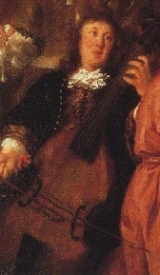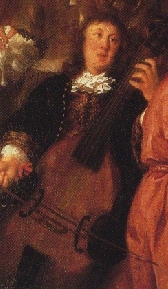
Chorale prelude
Encyclopedia
In music, a chorale prelude is a short liturgical composition for organ
using a chorale
tune as its basis. It was a predominant style of the German Baroque
era and reached its culmination in the works of J.S. Bach
, who wrote 46 (with a 47th unfinished
) examples of the form in his Orgelbüchlein
.
in the Baroque period is debated. One possibility is that they were used to introduce the hymn about to be sung by the congregation, usually in a Protestant, and originally in a Lutheran, church.
line above or below the melody.
As an independent genre, the chorale prelude began with the works of Dieterich Buxtehude
, 48 of which are listed as extant in New Grove II. Numerous examples also exist from the 19th and 20th centuries, including some by Johannes Brahms
and Max Reger
. Works in the form continue to be composed in the present day.
 Probably, the earliest record of a melody used in chorale prelude by Johann Sebastian Bach
Probably, the earliest record of a melody used in chorale prelude by Johann Sebastian Bach
is his arrangement of Gelobet seist du, Jesu Christ
(BWV 604). this melody appears in a manuscript c1370, in the city of Celle
. Later, it appears with an original text by Martin Luther, printed in the Geystliche Gesangk Buchleyn (edited by Johann Walter), in Wittenberg, 1524. In 1715, the hymn's book of Gotha
, Germany, had already printed the melody of Gelobet seist du, Jesu Christ. Soon after, in 1717, Bach was requested by the Duke of Saxe Gotha to present a musical passion.
However, in a singular style, the chorale prelude first appeared in the works of Dieterich Buxtehude
(1637-1707), and includes 48 extensive compositions.
Besides Bach, Pachelbel's music is of special importance, with many of his chorale preludes elaborating upon the Protestant melodies of Middle and Northern Germany.
by Johannes Brahms
, Max Reger
's and Samuel Barber
's. Works such as these continue to be produced nowadays such as Helmut Walcha
's four volumes and the seven volumes of Flor Peeters
.
In addition to Max Reger's Opus 79b, he also wrote 30 small chorale preludes, op. 135a (1914)
Organ (music)
The organ , is a keyboard instrument of one or more divisions, each played with its own keyboard operated either with the hands or with the feet. The organ is a relatively old musical instrument in the Western musical tradition, dating from the time of Ctesibius of Alexandria who is credited with...
using a chorale
Chorale
A chorale was originally a hymn sung by a Christian congregation. In certain modern usage, this term may also include classical settings of such hymns and works of a similar character....
tune as its basis. It was a predominant style of the German Baroque
Baroque music
Baroque music describes a style of Western Classical music approximately extending from 1600 to 1760. This era follows the Renaissance and was followed in turn by the Classical era...
era and reached its culmination in the works of J.S. Bach
Johann Sebastian Bach
Johann Sebastian Bach was a German composer, organist, harpsichordist, violist, and violinist whose sacred and secular works for choir, orchestra, and solo instruments drew together the strands of the Baroque period and brought it to its ultimate maturity...
, who wrote 46 (with a 47th unfinished
Unfinished work
An unfinished work is creative work that has not been finished. Its creator may have chosen never to finish it or may have been prevented from doing so by circumstances outside of their control such as death. Such pieces are often the subject of speculation as to what the finished piece would have...
) examples of the form in his Orgelbüchlein
Orgelbüchlein
The Orgelbüchlein was written by Johann Sebastian Bach during the period of 1708–1714, while he was court organist at the ducal court in Weimar...
.
Function
The liturgical function of a chorale preludePrelude (music)
A prelude is a short piece of music, the form of which may vary from piece to piece. The prelude can be thought of as a preface. It may stand on its own or introduce another work...
in the Baroque period is debated. One possibility is that they were used to introduce the hymn about to be sung by the congregation, usually in a Protestant, and originally in a Lutheran, church.
Style
Although it was typically a polyphonic setting, the melody would be plainly audible. There was sometimes an obbligatoObbligato
In classical music obbligato usually describes a musical line that is in some way indispensable in performance. Its opposite is the marking ad libitum. It can also be used, more specifically, to indicate that a passage of music was to be played exactly as written, or only by the specified...
line above or below the melody.
As an independent genre, the chorale prelude began with the works of Dieterich Buxtehude
Dieterich Buxtehude
Dieterich Buxtehude was a German-Danish organist and composer of the Baroque period. His organ works represent a central part of the standard organ repertoire and are frequently performed at recitals and in church services...
, 48 of which are listed as extant in New Grove II. Numerous examples also exist from the 19th and 20th centuries, including some by Johannes Brahms
Johannes Brahms
Johannes Brahms was a German composer and pianist, and one of the leading musicians of the Romantic period. Born in Hamburg, Brahms spent much of his professional life in Vienna, Austria, where he was a leader of the musical scene...
and Max Reger
Max Reger
Johann Baptist Joseph Maximilian Reger was a German composer, conductor, pianist, organist, and academic teacher.-Life:...
. Works in the form continue to be composed in the present day.
Form
Most of the chorale prelude form is a theme and variation with a "long A" where the voices retrograde, invert, imitate while following the original basso continuo.Baroque period

Johann Sebastian Bach
Johann Sebastian Bach was a German composer, organist, harpsichordist, violist, and violinist whose sacred and secular works for choir, orchestra, and solo instruments drew together the strands of the Baroque period and brought it to its ultimate maturity...
is his arrangement of Gelobet seist du, Jesu Christ
Gelobet seist du, Jesu Christ
Gelobet seist du, Jesu Christ is a Lutheran chorale of 1524, with words written by Martin Luther. For centuries the chorale has been the prominent hymn for Christmas Day in German speaking Lutheranism, but has also been used in different translations internationally...
(BWV 604). this melody appears in a manuscript c1370, in the city of Celle
Celle
Celle is a town and capital of the district of Celle, in Lower Saxony, Germany. The town is situated on the banks of the River Aller, a tributary of the Weser and has a population of about 71,000...
. Later, it appears with an original text by Martin Luther, printed in the Geystliche Gesangk Buchleyn (edited by Johann Walter), in Wittenberg, 1524. In 1715, the hymn's book of Gotha
Gotha (town)
Gotha is a town in Thuringia, within the central core of Germany. It is the capital of the district of Gotha.- History :The town has existed at least since the 8th century, when it was mentioned in a document signed by Charlemagne as Villa Gotaha . Its importance derives from having been chosen in...
, Germany, had already printed the melody of Gelobet seist du, Jesu Christ. Soon after, in 1717, Bach was requested by the Duke of Saxe Gotha to present a musical passion.
However, in a singular style, the chorale prelude first appeared in the works of Dieterich Buxtehude
Dieterich Buxtehude
Dieterich Buxtehude was a German-Danish organist and composer of the Baroque period. His organ works represent a central part of the standard organ repertoire and are frequently performed at recitals and in church services...
(1637-1707), and includes 48 extensive compositions.
Besides Bach, Pachelbel's music is of special importance, with many of his chorale preludes elaborating upon the Protestant melodies of Middle and Northern Germany.
Romantic period and twentieth century
There are several examples of 19th and 20th Century chorale preludes, for instance, the Eleven Chorale PreludesEleven Chorale Preludes
The Eleven Chorale Preludes, Op. 122, are a collection of chorale preludes for organ by Johannes Brahms, composed in 1896, and published posthumously in 1902....
by Johannes Brahms
Johannes Brahms
Johannes Brahms was a German composer and pianist, and one of the leading musicians of the Romantic period. Born in Hamburg, Brahms spent much of his professional life in Vienna, Austria, where he was a leader of the musical scene...
, Max Reger
Max Reger
Johann Baptist Joseph Maximilian Reger was a German composer, conductor, pianist, organist, and academic teacher.-Life:...
's and Samuel Barber
Samuel Barber
Samuel Osborne Barber II was an American composer of orchestral, opera, choral, and piano music. His Adagio for Strings is his most popular composition and widely considered a masterpiece of modern classical music...
's. Works such as these continue to be produced nowadays such as Helmut Walcha
Helmut Walcha
Helmut Walcha was a blind German organist who specialized in the works of the Dutch and German baroque masters and is known for his recordings of the complete organ works of Johann Sebastian Bach.- Biography :Born in Leipzig, Walcha was blinded at age 19 after vaccination for smallpox...
's four volumes and the seven volumes of Flor Peeters
Flor Peeters
Flor Peeters was a Flemish composer, organist and teacher.-Biography:Born and raised in the village of Tielen , he was the youngest child in a family of eleven...
.
Max Reger
Chorale Prelude for Organ, op. 79b (1900-1904)- 'Ach Gott, verlaß mich nicht
- 'Ein' feste Burg ist unser GottA Mighty Fortress is Our God"A Mighty Fortress Is Our God" is the best known of Martin Luther's hymns. Luther wrote the words and composed the melody sometime between 1527 and 1529. It has been translated into English at least seventy times and also into many other languages...
- 'Herr, nun selbst den Wagen halt'
- 'Morgenglanz der Ewigkeit
- 'Mit Fried und Freud fahr ich dahin'
- 'We weiss, wie nahe mir mein Ende'
- 'Auferstehn, ja auferstehn wirst Du'
- 'Christ ist erstanden von dem Tod'
- 'Christus, Der ist mein Leben'
- 'Mit Fried und Freud fahr ich dahin'
- 'Nun danket alle Gott'
- 'Herr, nun selbst den Wagen halt
- 'Warum solit ich mich gramen'
In addition to Max Reger's Opus 79b, he also wrote 30 small chorale preludes, op. 135a (1914)

